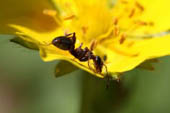
Purpose
To prepare an ant so that its brain and nervous system may be photographed through a microscope. You will then take photographs of the ant using a digital camera for documentation.
Additional information
The ant’s nervous system is very, very tiny but also very complex and amazing to photograph. We can learn a lot about an ant and our own bodies, respectively, when we photograph an ant's nervous system.
Sponsored Links
Required materials
- Microscope
- Slides
- Ants
- Rubbing alcohol
- Digital camera
- Tweezers
- One or two small glass vials
- Microscope camera adapter
- Ants
Estimated Experiment Time
Several hours
Step-By-Step Procedure
- 1. Begin by placing an ant in each vial, using tweezers. Generally, you will only need about 3-4 vials so you can choose the best specimen.
- 2. Fill each vial ¼ of the way full with rubbing alcohol, completely covering the ant. Let sit for at least one hour but no longer than an hour and a half. This will prepare the ants for the photograph by making them somewhat translucent so their brains and nervous systems will show up on the camera.
- 3. While the ants are soaking in the alcohol, use this time to set up your microscope camera adapter with your microscope.
- 4. When the ants have finished soaking in the alcohol solution, remove each ant with the tweezers and place them carefully on their own slide.
- 5. View each ant with the microscope, determining which ant is the best specimen. You’ll want to choose the one where the brain and nervous system are the most noticeable.
- 6. Begin photographing the best specimen, taking care to photograph all parts of the ant. Try using different magnifications to produce different results. Since you are using a digital camera, you can take plenty of pictures and eliminate all but the best pictures using your computer at a later time.
Note
You will most likely find that you are able to gain access to a microscope at your school – just ask permission to use it for your project. You can find the microscope adapter for your digital camera online or at specialty biological supply stores.
Observation
When sorting through the photographs on your computer, choose the photos that best illustrate the complexity of the ant’s nervous system. Choose clear photographs that are without blur.
Result
As a result of this project, you will be able to photograph and document the inner workings of the ant’s nervous system. How does the ant’s nervous system compare to a human nervous system? Is it similar, just on a smaller scale or is it completely different? What is unique about the ant’s nervous system?
Sponsored Links
Take a moment to visit our table of Periodic Elements page where you can get an in-depth view of all the elements,
complete with the industry first side-by-side element comparisons!